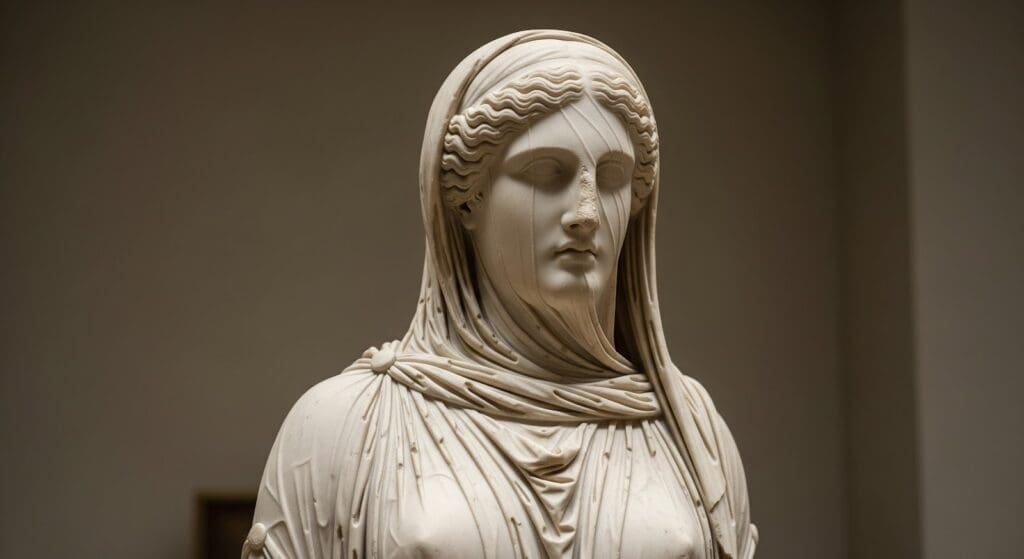Marble Sculpture with Veil: The Mastery Behind This Captivating Art Form
Few sculptural feats command as much awe as marble sculptures with veils. This unique artistic tradition captures the viewer’s imagination by transforming solid stone into a sheer veil, so delicate it seems it could flutter with breath. Whether it’s the famed Veiled Christ by Giuseppe Sanmartino or Corradini’s Veiled Vestal Virgin, these works are some of the most famous examples of sculptural illusion, technical precision, and artistic brilliance.
At Quarra Stone, we celebrate this remarkable intersection of beauty and craftsmanship. These statues represent the apex of marble carving techniques and embody the enduring power of traditional marble sculpture—a craft honed across centuries and rooted in the marble-rich heritage of Italy, particularly northern Italy, where white marble is still quarried from legendary quarries.
The Origin of Marble Sculpture With Veil

The tradition of veiled figures has its roots in Ancient Greece, during the classical era when sculptors first began to explore ways to express the human form with fluidity and grace. Greek sculpture set the standard for craftsmanship and artistic innovation, profoundly influencing the tradition of veiled figures in later periods. The use of veils as a creative technique emerged in early sculpture, with artists skillfully carving delicate, translucent drapery to create the illusion of fabric and modesty. The classical period placed high value on idealized beauty, and the illusion of drapery over flesh became a visual metaphor for modesty, purity, and divine protection, showcasing the artist’s technical mastery.
Veiled statues often depicted virtuous women, goddesses, and sacred figures such as the Virgin Mary or Mary Magdalene. One of the earliest famous examples is the Veiled Vestal Virgin, a subject that other artists have reinterpreted over time. These marble statues were more than decorative—they carried deep symbolic and religious meaning that spoke to the values of the time.
Marble: The Material of Choice
Marble—a metamorphic rock composed mainly of calcium carbonate—has been the preferred medium for sculptors for millennia. Renowned for its ability to reflect and absorb light, white marble has a subtle translucency mimics human skin, making it ideal for creating lifelike forms. White marble is generally preferred for sculpture due to its purity and ability to showcase fine detail, while colored varieties are exceptions for specific effects. The materials that make up marble, including impurities, directly impact its suitability for sculpture and the final appearance of the work. Marble is often contrasted with limestone, a sedimentary rock used in architecture and sculpture, but limestone lacks the same translucency and fine grain. Sculptors prize flawless marble quarried from Carrara, located in northern Italy, and other regions around the Aegean Sea for its purity and even grain. The mountains of northern Italy are especially famous as the source of Carrara marble, and Italy remains a global leader in marble production and artistry. Alongside marble, other stones are also used in sculpture, each offering unique properties for artists. High-quality marble for sculpture is sourced from renowned quarries, which provide the best raw materials for artistic creation.
The translucent marble used in veiled sculpture allows light to pass through the thinnest sections, such as a carved veil, giving the illusion of transparency. Unlike coloured ones, which may hide detail, white stone provides a pristine canvas for subtle textures and nuanced forms.
The Carving Process: From Block to Masterpiece
Creating a marble sculpture with a veil is an extraordinary feat requiring artistic vision and technical mastery. The carving process begins with selecting a high-quality block of white marble. Sculptors often start by modeling the figure in clay, allowing them to refine details and proportions before carving marble. Marble offers several advantages for veiled sculptures, such as its translucency, ability to absorb and refract light, and workability, making it ideal for achieving delicate effects. From there, the sculptor drafts the figure and then carves marble using chisels, files, and abrasives. The veil is often sculpted last, with ultra-fine tools that thin the surface until it appears sheer.
One mistake could ruin months of work, especially when carving intricate folds or facial expressions beneath the veil. The stone carver must navigate the delicate balance between illusion and structure without too much difficulty, relying on experience and instinct. Polishing is the final step, enhancing the marble’s surface and appearance to achieve a smooth, shiny finish.
Tools like the chisel must be wielded with great care, as even the smallest detail in the veil or the young woman’s form underneath can be the difference between a convincing illusion and a lifeless stone.
Symbolism and Meaning Behind the Veil
The veil in veiled marble sculptures is far more than a technical marvel—it is a powerful symbol woven into the very fabric of art history. In ancient Greece, veiled figures were often used to represent virtuous women, their modesty and humility captured in the delicate folds of translucent marble. The veil acts as a visual metaphor, suggesting purity and the presence of hidden depths beneath the surface. This illusion, achieved through masterful carving, invites viewers to contemplate what lies beyond the visible, turning the sculpture into a meditation on mystery and revelation.
The veiled virgin, for example, stands as an enduring emblem of innocence and spiritual grace, while other veiled figures evoke themes of national identity and the quiet strength of women. The interplay of light on the marble’s surface enhances the illusion, making the body beneath the veil appear both revealed and concealed. This duality is central to the allure of veiled sculptures, as the artful rendering of fabric over flesh blurs the line between the seen and the unseen, drawing us into a world where stone seems to breathe with life and meaning.
Iconic Examples of Veiled Marble Sculpture

Among the most famous examples of this art form is the Veiled Christ by Giuseppe Sanmartino, a marble statue in Naples. This masterpiece is celebrated for how the veil appears to cling to the human form, revealing every anatomical detail beneath while conveying a sense of softness and weight. The veiled figure’s image enhances the sculpture’s symbolic meaning, adding layers of mystery and virtue to its artistic representation.
Another iconic work is Antonio Corradini’s Veiled Lady—a subject he returned to multiple times. His series of veiled women is some of the most breathtaking in European art, showcasing the illusion of fabric carved so delicately it seems woven from air. The Veiled Vestal Virgin, also attributed to Corradini, stands as an enduring tribute to the technical and emotional depths that sculpture can achieve. Significant veiled marble sculptures and collections can be found in Rome, further establishing the city as a central hub of classical art and sculpture heritage. During the Victorian era, veiled sculptures became especially popular in private and public collections, reflecting their widespread appeal and cultural significance.
These famous examples are not just showpieces of technique; they are repositories of cultural heritage, embodying their time’s values, ideals, and aesthetics.
Cultural Significance Through the Ages
Veiled marble sculptures have transcended their origins to become cultural heritage icons, resonating across centuries and civilizations. In the classical era of ancient Greece, artists used veiled figures to honor goddesses and virtuous women, embedding ideals of beauty and morality into their marble creations. As the tradition evolved, the Renaissance brought a renewed fascination with the human form, and artists like Antonio Canova and Giuseppe Sanmartino elevated the veiled figure to new heights of artistry and expression.
During the Victorian era, the veiled figure became a popular motif in public and private collections, admired for its technical brilliance and symbolic richness. These sculptures were not merely decorative—they reflected societal values, spiritual beliefs, and artistic innovation. Today, veiled figures continue to inspire artists and captivate audiences, their enduring presence a testament to the universal appeal of marble, the skill of generations of sculptors, and the timeless power of art to convey complex ideas through the simplest of forms.
The Modern Revival of Traditional Marble Sculpture
While such artistry originated in antiquity, contemporary artists and sculptors continue to push the boundaries of artisan marble sculpting. At Quarra Stone, we’ve seen a renewed appreciation for these historic techniques as architects and designers seek to incorporate sculptural forms into modern architectural projects.
Whether restoring a classical period masterpiece or fabricating new marble statues inspired by the veiled tradition, the legacy lives on. Today’s stone carvers may use modern tools, but the essence of their work remains rooted in ancient disciplines, bringing the past forward through decorative arts that enrich both public spaces and private collections.
Preserving the Legacy: Conservation of Veiled Marble Masterpieces

Safeguarding the beauty and integrity of veiled marble masterpieces is essential to preserving our shared cultural heritage. While marble is prized for its luminous texture and ability to capture the finest details, it is a relatively soft stone, vulnerable to the effects of time, environment, and human touch. The conservation of these sculptures requires a careful balance between restoration and preservation, with conservators meticulously assessing each piece’s material, surface, and texture.
Advanced techniques, such as gentle cleaning, consolidation of fragile areas, and precise repairs, are employed to maintain the original artistry without compromising the sculpture’s authenticity. Modern technologies like 3D scanning and digital imaging have revolutionized the field, allowing for detailed documentation and ongoing monitoring of each artwork’s condition. Through these efforts, famous examples like the Veiled Lady and the Veiled Christ are protected for future generations, ensuring their beauty, craftsmanship, and significance in art and sculpture remain undiminished. By honoring the legacy of these masterpieces, we celebrate the achievements of past artists and the enduring allure of marble as a medium for expressing the deepest mysteries of the human experience.
Why Marble Sculpture with Veil Endures
The enduring appeal of veiled lady and veiled virgin sculptures lies in their paradox—they are both solid and ethereal, heavy and weightless. This tension is part of what makes them so mesmerizing. Each statue is a testament to human creativity and technical excellence, inviting viewers to contemplate the skill required to shape stone and the symbolic meanings behind the veil itself.
At Quarra Stone, we understand the value of preserving and advancing this noble tradition. Our passion for sculpture, art, and heritage drives us to support projects that honor the old while innovating for the future. From public installations to museum-quality works, our commitment to excellence ensures that each piece of marble, no matter how ambitious, is a work of enduring beauty.
Frequently Asked Questions
What is a marble sculpture with a veil?
A marble sculpture with a veil is a masterful art form where sculptors carve solid marble to create the illusion of a delicate, translucent veil draped over a figure. This technique transforms stone into what appears to be sheer fabric, so realistic it could flutter in the breeze. Famous examples include Giuseppe Sanmartino’s Veiled Christ and Antonio Corradini’s Veiled Lady series, which represent the pinnacle of sculptural craftsmanship and artistic illusion.
How do sculptors create the illusion of transparency in marble?
The illusion of transparency is achieved through the unique properties of white marble and exceptional carving skill. High-quality marble has subtle translucency that allows light to pass through thin sections. Sculptors carefully thin the marble in veil areas using ultra-fine tools, creating delicate sections that light can penetrate, giving the appearance of sheer fabric. The interplay of light and shadow on these carved surfaces enhances the realistic effect.
What tools are used to carve veiled marble sculptures?
Sculptors use a variety of specialized tools, including chisels of different sizes, files, and abrasives. The process begins with rougher tools to shape the basic form and progresses to increasingly fine instruments. The veil sections require the most delicate tools to achieve the paper-thin marble that creates the transparency effect. Modern sculptors may incorporate contemporary tools, but the fundamental techniques remain rooted in centuries-old traditions.
Why is Carrara marble preferred for veiled sculptures?
Carrara marble from northern Italy is prized for its exceptional purity, fine grain, and subtle translucency miming human skin. This white marble has minimal impurities and an even consistency that allows for highly detailed carving without unexpected flaws or fractures. Its ability to reflect and absorb light makes it ideal for creating lifelike forms, while its workability enables sculptors to achieve the ultra-thin sections necessary for convincing veil effects.
What is the symbolic meaning behind veiled figures in sculpture?
Veiled figures carry deep symbolic significance, representing purity, modesty, virtue, and spiritual grace. In ancient Greece, veils symbolized the modesty of virtuous women and goddesses. The veil visualizes hidden depths and mystery, inviting contemplation of what lies beneath the surface. This duality between revelation and concealment adds layers of meaning, making these sculptures meditations on themes like innocence, protection, and the sacred feminine.
How long does it take to create a veiled marble sculpture?
Creating a veiled marble sculpture is a highly time-consuming process that can take months or even years depending on the size and complexity. The sculptor must first model the figure in clay, then carefully transfer the design to marble. The veil is typically carved last, requiring painstaking precision since one mistake could ruin months of work. The delicate nature of the translucent sections means progress is necessarily slow and methodical.
What are the most famous examples of veiled marble sculptures?
The most renowned examples include Giuseppe Sanmartino’s Veiled Christ in Naples, which is celebrated for how the veil clings to every anatomical detail while maintaining softness and weight. Antonio Corradini’s series of veiled women, including the Veiled Vestal Virgin and multiple versions of the Veiled Lady, are considered masterpieces of European art. These works showcase the technical and emotional depths that marble sculpture can achieve.
How are veiled marble sculptures preserved and conserved?
Conservation requires careful balance between restoration and preservation since marble is relatively soft and vulnerable to environmental damage and human touch. Conservators use gentle cleaning techniques, consolidation of fragile areas, and precise repairs while maintaining authenticity. Modern technologies like 3D scanning and digital imaging allow detailed documentation and monitoring. The goal is to protect these masterpieces for future generations without compromising their original artistry.
Can contemporary artists still create veiled marble sculptures?
Contemporary artists and sculptors continue this tradition, often combining classical techniques with modern tools and approaches. While the fundamental skills remain rooted in ancient disciplines, today’s stone carvers may use updated equipment alongside traditional methods. There’s been a renewed appreciation for these historic techniques as architects and designers seek to incorporate sculptural forms into modern projects, ensuring the legacy continues.
What makes veiled marble sculptures so captivating to viewers?
The enduring appeal lies in their paradoxical nature—they appear solid and ethereal, heavy yet weightless. This tension creates a mesmerizing effect that challenges our perception of what stone can achieve. Each sculpture represents extraordinary human creativity and technical excellence, inviting viewers to contemplate the incredible skill required and the deeper symbolic meanings. The way light plays across the carved surfaces brings the stone to life, creating an almost magical viewing experience.

